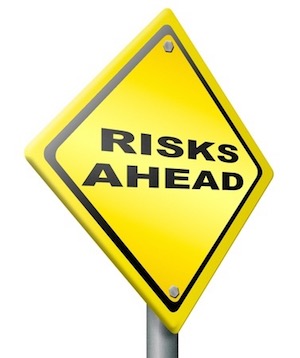 New inventors are often unaware of the quid pro quo that is fundamental to the patent system.
New inventors are often unaware of the quid pro quo that is fundamental to the patent system.
The inventors must show the world their innermost secrets of how to make or use their invention. In exchange, the government grants a limited right in the form of a patent.
One of the options for the inventor is to not to file a patent, but simply to keep their invention secret. The most common examples are the formula for Coca Cola or Colonel Sander’s secret herbs and spices. Both of these examples could have been patented, but were not. From a business standpoint, these were the right decisions.
There are many examples of patents that had virtually no value because the claims were undetectable, unenforceable, or ridiculously narrow. In the process of getting a worthless patent — a bad patent, the company gave up their complete roadmap for how to manufacture and use their product.
These bad patents are not just a waste of money, but their competitive advantage is eviscerated by disclosing everything they know. The bottom line: Some patent applications can be very damaging to a startup company.
Part of the analysis prior to filing a patent is to first estimate how broad or narrow the patent might be, then evaluate whether the patent – at that breadth – would be worth pursuing. This analysis starts with a patent search.
Many investors want to check the box of “is it patented?”. However, most investors are not aware that the patent will post all the company secrets online for all competitors – with virtually no benefit to the company. The decision to get a patent or not needs to be made carefully and thoughtfully, and many companies are better off with no patent protection.
How does this happen?
 One very typical scenario is when a startup company thinks they need to get a patent and do so in a panic, often just before they do a presentation for the first time and publically disclose their invention to the world.
One very typical scenario is when a startup company thinks they need to get a patent and do so in a panic, often just before they do a presentation for the first time and publically disclose their invention to the world.
It is conventional – but a terrible practice – for patent attorneys to file provisional patent applications in this situation.[1] The attorneys get called at the last minute and grab whatever information is available, slap a cover sheet on it, and file a provisional patent application.
Some companies put their pitch decks, pages of lab notebooks, internal decision making processes, internal financial projections, even source code for their software in the provisional patent application. This is done with the mistaken belief that the provisional application will not be made public.[2]
This situation happens because the patent attorney figures they will sort it out later. Maybe something in one of the documents will support some patent claims that we want to file a year from now.
From the patent attorney’s perspective, the larger pile of information, however disorganized, the more likely it will be that they can find something patentable.[3]
From the client’s perspective, they have given up their most valuable trade secrets, including all their internal documents, in exchange for their patent.[4]
As will be explained below in Chapter 3, the first patent that a company does is often the least valuable patent. This makes sense because both the technology and business risks are the highest at this stage. Why give up the most to get the least?
What to do if this happens?
How should an investor respond when a startup files these types of “kitchen sink” provisional patent applications?
One option to consider is to abandon the provisional patent application and start all over.
This appears to be a very drastic measure on the surface, but not as drastic as it sounds. In many cases, these types of patent applications are very thin when it comes to describing the actual patent claims.
Consequently, this provisional application does not actually give the right of priority to the filing date, so the real right of priority would only start with the second, non-provisional application.
In this case, the company did not have decent protection to begin with, so abandoning the provisional application and writing a good non-provisional application has no downside. In fact, there is a big upside because the company’s trade secrets are not published.
Note: This is an excerpt from “Investing In Patents” by Russ Krajec. Russ is CEO and founder of BlueIron IP, an investment company that finances patents for startup companies.
_______________
[1] The US allows for a “provisional” patent application, which serves as a placeholder for a “non-provisional” patent application, which must be filed within a year after the provisional patent application. The non-provisional application is the only type of patent application that gets examined by the USPTO.
Provisional patent applications are often touted as the “poor man’s patent”. As described later in the book, provisional patent applications are one of the big mistakes that startup companies make with their patents.
[2] When the subsequent non-provisional application is published, the provisional application then becomes part of the public record. If there is no subsequent non-provisional application, the provisional application will remain secret forever. But, if it was abandoned, it was a waste of time.
[3] This is just another example of how the attorney’s interest in getting patents can severely compromise the company’s interests.
[4] The company would have a very hard time enforcing any of their “trade secrets” when they publically disclose them in a patent application, because they would no longer be trade secrets. For example, a disgruntled employee may join a competitor and bring all the trade secrets with them, and the company could not bring a claim against the employee to try to stop them from sharing the “trade secrets”.

![[IPWatchdog Logo]](https://ipwatchdog.com/wp-content/themes/IPWatchdog%20-%202023/assets/images/temp/logo-small@2x.png)

![[Advertisement]](https://ipwatchdog.com/wp-content/uploads/2024/05/Quartz-IP-May-9-2024-sidebar-700x500-1.jpg)
![[Advertisement]](https://ipwatchdog.com/wp-content/uploads/2024/04/Patent-Litigation-Masters-2024-sidebar-last-chance-700x500-1.jpg)

![[Advertisement]](https://ipwatchdog.com/wp-content/uploads/2021/12/WEBINAR-336-x-280-px.png)
![[Advertisement]](https://ipwatchdog.com/wp-content/uploads/2021/12/2021-Patent-Practice-on-Demand-recorded-Feb-2021-336-x-280.jpg)
![[Advertisement]](https://ipwatchdog.com/wp-content/uploads/2021/12/Ad-4-The-Invent-Patent-System™.png)






Join the Discussion
12 comments so far.
Dave Brough
August 30, 2016 01:56 pmBenny,
The thing is, I sold the ‘world-wide’ rights, not just the patent rights, this leaving me open to suit. Then again, one wonders if, after shafting me, they would have the balls to sue – or because I’m about to go after them, counter-sue.
But you’ve given me something to consider.
Thanks.
Benny
August 30, 2016 01:00 pmDave,
In the real world, not having patent protection doesn’t prevent you from selling your product, and the grant of patent rights doesn’t prevent anyone from importing Far—East copies and ignoring cease and desist letters. People will always buy a good product and shun a poor product, and the free market will rule.
Dave Brough
August 30, 2016 12:53 pmBenny,
If there’s ‘nothing to protect’, wouldn’t the examiner just reject the application?
I get your suggestion about thinking twice before throwing money at attorneys, especially in my case where – because of this scenario, where they won’t return the rights, thus preventing me from selling my product – I now live below the poverty line. Bummer, eh?
Thanks for holding my hand.
Benny
August 30, 2016 12:29 pmDave,
A provisional claim, and even a non—provisional claim before examination and grant, protects nothing. It may well be the examiners position that you have nothing to protect. Prior to a patent issuing, you still have the option of filing a continuation, and even after grant a re—issue is not ruled out. I would think twice then twice more before throwing money at attorneys, though — the chance of return on investment in patents is pretty slim.
Dave Brough
August 30, 2016 10:34 amBenny,
I’m sure that has happened, but in this case, I don’t think it was ‘ignorance’.
After repudiating our agreement, these ‘managers’ first advised that they had no intention to file and would return the rights, but then, when I asked for compensation, held the return of the rights hostage in an attempt to get me to agree not to sue. They had, in my provisional filing, broad claims that protected all aspects of the invention, but when I refused to accept their terms, then devoted substantial effort to redraft my claims into oblivion, knowing that I would have to sue to get the rights and then go through a lot of effort and money to continue. That’s what I call ‘sabotage’, aka a poke in the eye.
PS Thanks for contributing.
Benny
August 30, 2016 01:16 amDave,
I’ve seen managers sabotage patents through ignorance. Don’t discount this possibility in your case.
Dave Brough
August 29, 2016 04:33 pmThanks Benny. Have you ever experienced a situation where (as I claim), the patent was deliberately sabotaged?
Benny
August 29, 2016 01:05 amDave,
a – I’ve seen a lot of ridiculously narrow patent claims, and b – it was usually the only way the applicant could get a granted patent, since they hadn’t really invented anything – just a different combination of known features to achieve a known result. Very occaisionally I see a patent claim where it appears as though the patent drafter doesn’t understand the technology and goofs it up.
Dave Brough
August 28, 2016 12:33 pmOn ‘bad patents’, just wondering if anyone has come across a patent written so badly and narrowly that anyone could do a workaround to defeat it? I would call it a deliberate act of sabotage.
In my case, I signed over the rights to a company that refused to pay or return the rights, but (so I say) then, out of pure spite, on the last possible day (and even that is debatable) filed a narrow patent knowing that when I get the rights back, I’m going to have an uphill (and expensive, since I won’t have the benefit of micro-entity status that I otherwise would have had) to remake it into the broad patent originally intended.
For reference, look at US20160047097 A1
Comments appreciated.
Russ Krajec
June 2, 2016 07:54 amFor a startup company, there is a lot of logic to publish *early* rather than not at all.
As a co-founder of a software startup, we did early publication for two main reasons: (1) I wanted our investors and potential investors to be able to see the assets we had and (2) I wanted our patent applications to serve as prior art for our competitors as soon as possible.
My opinion is that electing not to publish harms the startup company more than it helps. It is yet another example of how patent attorneys often do the wrong thing for startups.
Benny
June 1, 2016 05:38 amKen,
Your approach would indeed be an advantage for some individual companies, but disastrous for the industry as a whole, since some companies will have invested vast resources in developing products which at the last moment they discover they cannot bring to market after a “submarine” patent surfaces. There are some very good reasons why the rules were changed to provide publication after 18 months. Not many good reasons to revert to past practices.
Ken
May 31, 2016 09:28 amCouldn’t this problem be alleviated if more inventors/startups took advantage of the option to NOT publish their application unless/until it issues? And that way, they could simply choose not to let it issue if they ultimately determine that what is deemed allowable is not worth going through with the public disclosure.
The only “price” for invoking such an option is promising not to seek international protection – which most independent inventors or entrepreneurs really can’t afford to do anyway (as many learn the hard way, i.e. by starting and then having to abandon, because the various costs involved prove to be so much greater than just doing U.S.).